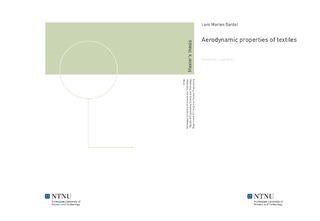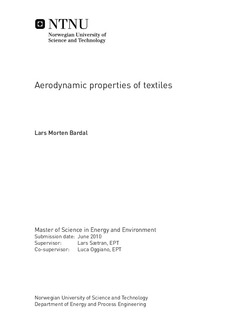| dc.contributor.advisor | Sætran, Lars | nb_NO |
| dc.contributor.advisor | Oggiano, Luca | nb_NO |
| dc.contributor.author | Bardal, Lars Morten | nb_NO |
| dc.date.accessioned | 2014-12-19T11:45:30Z | |
| dc.date.available | 2014-12-19T11:45:30Z | |
| dc.date.created | 2010-09-16 | nb_NO |
| dc.date.issued | 2010 | nb_NO |
| dc.identifier | 351902 | nb_NO |
| dc.identifier | ntnudaim:5755 | nb_NO |
| dc.identifier.uri | http://hdl.handle.net/11250/234016 | |
| dc.description.abstract | The aerodynamic drag force acting on a circular cylinder clad with knitted wool and polyester textiles has been investigated in wind tunnel experiments in this study. Particle image velocimetry (PIV) was utilized to determine the flow field, both around the separation point and a wake profile in the close wake. The drag forces and the characteristic CD curves were determined over a range of Reynolds numbers expected to contain flow transition, for a number of knitted textiles having different surface roughness characteristics. The effects of knitting parameters and type of yarn on the flow field were investigated. The parameters of interest to be examined were critical Reynolds number, separation point, growth of the wake and wake profile. The wool and polyester textiles examined showed dissimilar effects on the flow field. Both were clearly adding surface roughness, and hence tripping transition to turbulence at a lower Reynolds number than for the smooth cylinder. The wool textile did however turn out be a more effective turbulence trigger than expected. | nb_NO |
| dc.language | eng | nb_NO |
| dc.publisher | Institutt for energi- og prosessteknikk | nb_NO |
| dc.subject | ntnudaim | no_NO |
| dc.subject | SIE5 energi og miljø | no_NO |
| dc.subject | Varme- og energiprosesser | no_NO |
| dc.title | Aerodynamic properties of textiles | nb_NO |
| dc.type | Master thesis | nb_NO |
| dc.source.pagenumber | 14 | nb_NO |
| dc.contributor.department | Norges teknisk-naturvitenskapelige universitet, Fakultet for ingeniørvitenskap og teknologi, Institutt for energi- og prosessteknikk | nb_NO |

